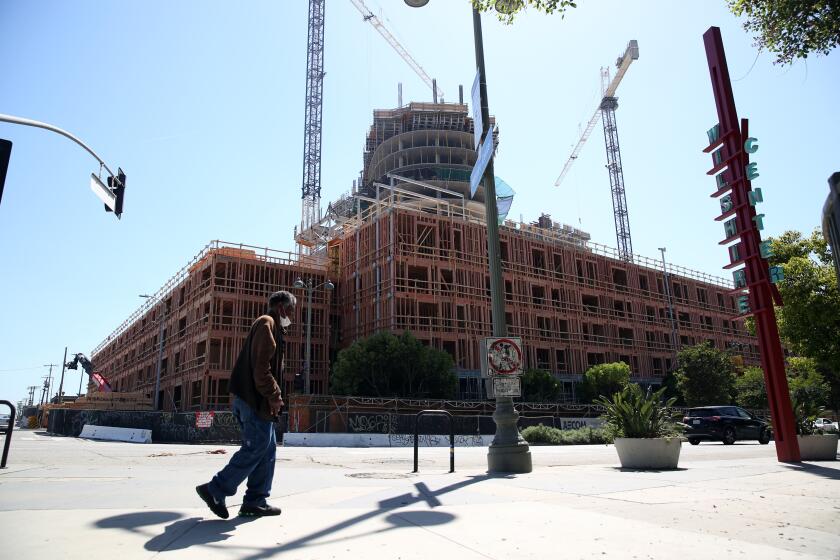Why Californians are fleeing this once-Golden State

- Share via
SACRAMENTO — It seems only yesterday that California’s population was nearly 40 million. Then more people left the state. Now we’re not even at 39 million.
The U.S. Census Bureau reported in March that California’s population as of last July had dropped to an estimated 38,965,000. That’s down by 75,400 in a year — and 573,000 below California’s peak of 39.5 million in 2020.
Entering this century, when California’s still-growing population was 34 million, we were predicted to reach 45 million by 2020 and almost 60 million by 2040. So much for that.
People have been fleeing this once-Golden State. And the exodus accelerated on Gov. Gavin Newsom’s watch.
That probably won’t be accentuated in Newsom’s State of the State speech — if he ever gives one this year. It’s already three months past the time governors traditionally have delivered their much-anticipated, annual address.
Newsom hates giving prepared speeches. But he loves pitching California. And a bolting citizenry doesn’t fit his usual narrative that all’s terrific.
Anyway, the fact that Newsom has been governor while constituents flee the state is mostly coincidental. Sure, state public policy decisions have helped motivate some people to leave. But they probably would have departed no matter who the governor was.
California just got too big for its carrying capacity — at least in the sprawling, ranch-house lifestyle that so many people covet and symbolizes the state’s easy-living persona.
“Grow and grow and grow and eventually there’s not enough room,” says Hans Johnson, a demographer at the nonpartisan Public Policy Institute of California.
“The easy places for growth have been used up. Growth today means infill development [in cities]. That’s expensive and controversial. Or you live further away from your job.”
Or leave the state and find cheaper housing almost anywhere.
Developers built fewer homes in California in 2023, potentially leading to higher prices and rents as a supply shortage worsens.
Out-of-state migration is the main cause of California’s continuing population loss. But there are other reasons too.
Post-World War II baby boomers — those born between 1946 and 1964 — are starting to die. And their kids and grandkids haven’t been producing enough babies to replace them.
“California’s fertility rate has fallen faster than most [states],” the public policy institute reported in October. “In 2008 its rate was above the national average (2.15). By 2020, it fell to the seventh lowest (1.52).”
The COVID-19 pandemic took a death toll, particularly on older people. Overall, deaths in California increased by 19% in 2020 over the previous year, the institute reported.
The pandemic also virtually shut down foreign immigration into California. It had been the main driver of population growth for several years. When COVID struck, visa restrictions were invoked to reduce the virus’ spread.
Legal and undocumented immigration have increased since the pandemic, “but not to prior levels — nowhere near,” Johnson says.
“California is no longer the preferred destination it used to be.”
For one thing, Johnson says, Mexico’s birth rate has significantly declined and its labor market is less competitive. Fewer Mexicans are heading north searching for work, although many Central Americans are seeking asylum, mostly in other states.
And another thing — something demographers usually don’t delve into: Trump administration policies clamped down especially on illegal immigration. The Biden administration eased up.

But “the biggest reason we’re losing population is that people are moving out,” Johnson says. “That has slowed, but we’re still losing hundreds of thousands to other states.” That’s a net loss after factoring in people moving to California.
And why are they leaving? Mainly because of California’s high cost of living, particularly housing. That’s the biggest reason movers cite.
The median cost of a California house was nearly $800,000 in November, more than double the $336,000 you’d pay in Texas, according to Redfin housing market data. In neighboring Arizona and Nevada, it was $435,000 and $479,000, respectively. These are destination states for departing Californians.
Californians are overwhelmingly enamored of the state and appreciate its diversity. Still, about 40% of residents are considering leaving, mostly because of the costs.
Blame California’s high costs of land and labor plus regulatory quagmires and neighborhood resistance to growth. Newsom and legislators have been wrestling with these issues for years and enacted new laws, but they haven’t generated much progress in making home buying more affordable.
During the pandemic, Johnson says, highly educated people with the opportunity to work remotely began leaving California because they could find affordable housing and do their jobs at home rather than commute long distances.
Also, higher-income people began leaving for states such as Texas and Nevada that don’t impose income taxes. California has the nation’s highest state income tax rate, 13.3%. We also have high sales and gas taxes. We’re a high tax state, a fact Newsom pooh-poohs.
About 60,000 more people moved from California to Texas than the other way in 2022. Experts point to housing, taxes and politics.
There’s evidence that some conservatives are leaving California because they can’t tolerate our liberal politics.
Many probably didn’t like Newsom’s shuttering of shops and schools during the pandemic. Other states were less restrictive.
The Idaho secretary of state reported in November that of nearly 30,000 ex-Californians who had moved to the Gem State, 75% registered to vote as Republicans. Only 10% signed up as Democrats.
That’s bad news for the declining California GOP.
What else does California’s continued population loss mean?
More room on the freeways and less congestion generally.
Less stress on our unstable water supply.
But also less tax revenue. With the top 20% of earners — those families making at least $120,000 a year — supplying 91% of the state income tax, a continued exodus is sure to lighten the Sacramento pocketbook. The state currently is facing a budget deficit of tens of billions of dollars. There’s an argument over the exact amount.
California loses national political clout as people leave. We’ll probably surrender two more U.S. House seats after the 2030 census. We lost one in 2020 when we were still growing.
One way to make California more enticing would be to offer a benefit that worked well for generations until the state got greedy in the 1970s: Free tuition at public universities for California residents. That would at least help prevent a brain drain.
More to Read
Sign up for Essential California
The most important California stories and recommendations in your inbox every morning.
You may occasionally receive promotional content from the Los Angeles Times.














